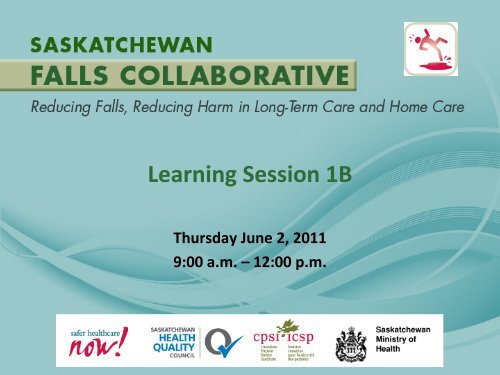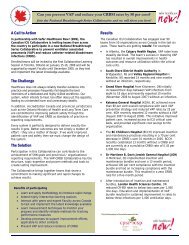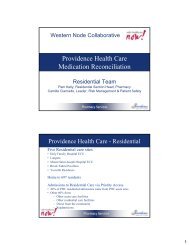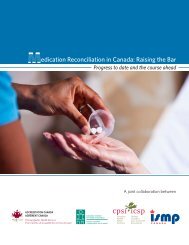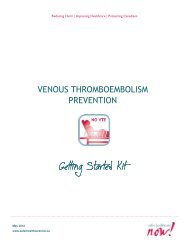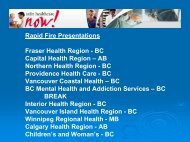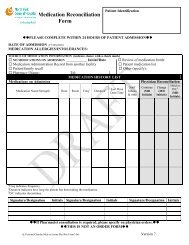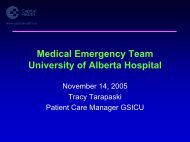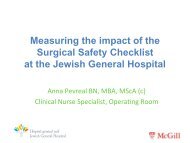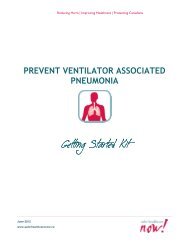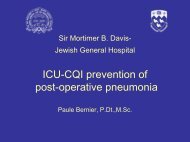SK Falls - Learning Session 1B - Safer Healthcare Now!
SK Falls - Learning Session 1B - Safer Healthcare Now!
SK Falls - Learning Session 1B - Safer Healthcare Now!
Create successful ePaper yourself
Turn your PDF publications into a flip-book with our unique Google optimized e-Paper software.
<strong>Learning</strong> <strong>Session</strong> <strong>1B</strong><br />
Thursday June 2, 2011<br />
9:00 a.m. – 12:00 p.m.
Welcome Back!<br />
Linda Restau and Laurie Weiman<br />
Ministry of Health
Collaborative Planning & Support Team<br />
Dr. Jenny Basran, Collaborative co-Chair and Clinical Leader<br />
Head & Assistant Professor, Division of Geriatric Medicine<br />
College of Medicine, University of Saskatchewan<br />
Geriatrician, Saskatoon Health Region<br />
Linda Restau, Collaborative co-Chair<br />
Saskatchewan Ministry of Health<br />
Laurie Weiman, Collaborative co-Chair<br />
Saskatchewan Ministry of Health<br />
Debra-Jane Wright, Health Quality Council<br />
Bruce Harries, Collaborative Strategic Advisor, Improvement<br />
Associates Ltd<br />
4-Jun-12<br />
Saskatchewan <strong>Falls</strong> Collaborative: Reducing <strong>Falls</strong> Reducing Harm in LTC and HC 3
Collaborative Planning & Support Team<br />
Leanne Couves, Collaborative Director, Improvement<br />
Associates Ltd.<br />
Tanis Rollefstad, Safety and Improvement Advisor, <strong>Safer</strong><br />
<strong>Healthcare</strong> <strong>Now</strong>! Western Region<br />
Angela Thiessen, Administrative & Technical Support, <strong>Safer</strong><br />
<strong>Healthcare</strong> <strong>Now</strong>! Western Region<br />
Nadine Glenn, Safety and Improvement Advisor, <strong>Safer</strong><br />
<strong>Healthcare</strong> <strong>Now</strong>! Western Region<br />
Melissa Pope, Event Coordinator<br />
4-Jun-12<br />
Saskatchewan <strong>Falls</strong> Collaborative: Reducing <strong>Falls</strong> Reducing Harm in LTC and HC 4
Collaborative Faculty<br />
Jody Rice, BScPT, Senior Physiotherapist Cypress Health<br />
Region<br />
Dr. Jane Richardson, BSP, PhD, FCSHP, Coordinator,<br />
Clinical Pharmacy Services, Saskatoon Health Region<br />
Dale Ternes, RN, BScN, Care Team Manager, Home<br />
Care Heartland Health Region<br />
4-Jun-12<br />
Saskatchewan <strong>Falls</strong> Collaborative: Reducing <strong>Falls</strong> Reducing Harm in LTC and HC 5
Collaborative Faculty<br />
Shanthi Johnson, PhD, RD, FDC, FACSM Professor and<br />
Associate Dean (Graduate Studies & Research) Faculty of<br />
Kinesiology & Health Studies Research Faculty, Saskatchewan<br />
Population Health & Evaluation Research Unit<br />
Cara Christian, Home Health Aide Regina Qu’Appelle Health<br />
Region<br />
Anita Meszaros, Occupational Therapist Kelsey Trail Health<br />
Region<br />
Patti Leugner, Special-Care Aide Pioneer Lodge Five Hills<br />
Health Region<br />
4-Jun-12<br />
Saskatchewan <strong>Falls</strong> Collaborative: Reducing <strong>Falls</strong> Reducing Harm in LTC and HC 6
Aim of the <strong>Falls</strong> Collaborative<br />
• Aim – reduce falls and injury from falls<br />
among long-term care residents and home<br />
care clients by at least 20% by March 2012.<br />
4-Jun-12 7
Objectives for Today’s <strong>Session</strong><br />
By the end of this sessions, participants will:<br />
• Review charters from <strong>Learning</strong> <strong>Session</strong> 1-A<br />
• Learn more about measurement for<br />
improvement<br />
• Plan first test cycle using change concepts<br />
from LS1-A<br />
• Understand how you will be supported and<br />
activities planned before <strong>Learning</strong> <strong>Session</strong> 2
Some feedback from LS1-A Poll<br />
• Useful:<br />
– Ideas to reduce falls e.g. Vitamin D<br />
– Model for Improvement<br />
– Examples<br />
– Discussions<br />
• To Improve:<br />
– From “shorten” to “need more time” – balance!<br />
– Interaction <br />
– More time to work in our teams <br />
4-Jun-12 Saskatchewan <strong>Falls</strong> Collaborative: Reducing <strong>Falls</strong> Reducing Harm in LTC and HC 9
Today’s Agenda<br />
Handout:<br />
• Review Collaborative Charters<br />
• Measurement for Improvement<br />
• Reporting – SHN & Monthly Reports<br />
• Break<br />
• Change Concepts & Ideas for Improvement<br />
• Model for Improvement (Part 2)<br />
• Action Period Activities, Assignments & Support<br />
• Summary<br />
4-Jun-12 10
Review Technology<br />
Tanis Rollefstad<br />
Safety and Improvement Advisor,<br />
<strong>Safer</strong> <strong>Healthcare</strong> <strong>Now</strong>!
Interacting in WebEx: Today’s Tools<br />
A few things on WebEx have<br />
Changed!<br />
Be prepared to use:<br />
- Pointer<br />
- Raise hand<br />
- CHAT<br />
4-Jun-12 12
Who is Online from Long Term Care<br />
Type Team Member Names Here Today:<br />
Extendicare Preston (Saskatoon)<br />
Extendicare Parkside (Regina Qu’Appelle)<br />
Kelvindell Lodge (Kelsey Trail)<br />
Last Mountain Pioneer Home (Saskatoon)<br />
LutherCare Communities (Saskatoon)<br />
Moose Mountain Lodge (Sun Country)<br />
Oliver Lodge (Saskatoon)<br />
Parkridge Centre (Saskatoon)<br />
Pioneer Lodge (Five Hills)<br />
Pleasant View Care Home/Wadena Integrated Facility (Saskatoon)<br />
Prairie North Health Authority<br />
Providence Place (Five Hills)<br />
Quill Plains Centennial Lodge and Health Center (Saskatoon)<br />
Regina Lutheran Home (Regina Qu’Appelle)<br />
Ross Payant Nursing Home (Five Hills)<br />
Saskatoon Health Region<br />
Sherbrooke Community Centre (Saskatoon)<br />
Stensrud Lodge (Saskatoon)<br />
Sunrise Health Region<br />
4-Jun-12 Saskatchewan <strong>Falls</strong> Collaborative: Reducing <strong>Falls</strong> Reducing Harm in LTC and HC 13
Who is Online from Home Care<br />
Team Member Names Here Today:<br />
Athabasca Health Authority<br />
Cypress Health Region (Home care/EMS)<br />
Cypress Health Region (Accreditation Team)<br />
Five Hills Health Region-Home Care<br />
Regina Qu`Appelle Health Region<br />
Saskatoon Health Region - Home Care<br />
Sun Country Health Region<br />
Sunrise Health Region Home Care<br />
Anyone Else?<br />
4-Jun-12 Saskatchewan <strong>Falls</strong> Collaborative: Reducing <strong>Falls</strong> Reducing Harm in LTC and HC 14
Reflection from LS1-A<br />
Use “Chat to All Participants”<br />
What was an a-ha moment?<br />
Or<br />
One activity since LS1-A?
Review Collaborative Charters<br />
Nadine Glenn<br />
Safety and Improvement Advisor,<br />
<strong>Safer</strong> <strong>Healthcare</strong> <strong>Now</strong>!
Some Key Points<br />
Project Name:<br />
Team Members:<br />
Team Sponsor:<br />
WHAT ARE WE TRYING TO ACCOMPLISH?<br />
HOW WILL WE KNOW A CHANGE IS<br />
AN IMPROVEMENT?<br />
Purpose of Project<br />
Scope & Boundaries<br />
Improvement Objectives<br />
Measures<br />
•<br />
•<br />
•<br />
•<br />
•<br />
•<br />
Improvement Charter<br />
• What are your goals for next 10 mths?<br />
• Specific objectives?<br />
• What resident or client population will<br />
your team focus on?<br />
• Do you have any constraints?<br />
Current Performance<br />
1.<br />
2.<br />
3.<br />
4.<br />
5.<br />
6.<br />
Goals<br />
1.<br />
2.<br />
3.<br />
4.<br />
5.<br />
6.<br />
• How will your team measure progress<br />
towards your aim? Objectives?<br />
• What data do we have? What data will we<br />
need?<br />
Project Name:<br />
HOW WILL WE MANAGE THE IMPROVEMENT PROJECT?<br />
Author:<br />
Date:<br />
Principles for Working Together<br />
Improvement Charter<br />
• Who is on your team?<br />
• What will they do?<br />
• How will we work together?<br />
• How often do we need to meet?<br />
Roles & Responsibilities<br />
Review Schedule<br />
Key Dates<br />
WHAT CHANGES CAN WE MAKE THAT WILL<br />
RESULT IN IMPROVEMENT?<br />
Change Concepts and Ideas to Test<br />
• Which ideas from Jenny and Anita’s<br />
presentation “Top 10” stood out for your<br />
team?<br />
• Where could your team start?<br />
Improvement Associates Ltd.<br />
Page 1<br />
Improvement Associates Ltd.<br />
Page 1
From your Charter<br />
Use “Chat to All Participants”<br />
What does your team want to<br />
accomplish by March 2012?
Example of Aim and Scope<br />
AIM<br />
• To decrease falls by 20% or more by March 2012.<br />
SCOPE<br />
• FHHR Home Care, home services clients team 1 &<br />
2.<br />
BOUNDARIES :<br />
• Exclude team 3 clients at this time until process<br />
tested<br />
-Pauline Osemlak and team<br />
4-Jun-12 Saskatchewan <strong>Falls</strong> Collaborative: Reducing <strong>Falls</strong> Reducing Harm in LTC and HC 19
Example of an Improvement Charter<br />
Cypress Health Region Long Term Care <strong>Falls</strong><br />
Prevention Team:<br />
Purpose of Project<br />
• To decrease the # of residents that fall in<br />
Cypress Health Region Long Term Care<br />
facilities by 30% by March 31, 2012.<br />
4-Jun-12 Saskatchewan <strong>Falls</strong> Collaborative: Reducing <strong>Falls</strong> Reducing Harm in LTC and HC 20
Measurement for Improvement<br />
Nadine Glenn and Anita Meszaros
Distinctions in Measurement
Levels of Measurement<br />
Typically, you will conduct measurement at<br />
different levels in your project:<br />
1. Project level: How will we know the change is an<br />
improvement?<br />
2. PDSA-level measures: to help you answer the<br />
questions (predictions) in each PDSA cycle you<br />
undertake<br />
4-Jun-12 Saskatchewan <strong>Falls</strong> Collaborative: Reducing <strong>Falls</strong> Reducing Harm in LTC and HC 23
Recommended Measures<br />
• Fall Rate – Number of falls per 1,000 resident (client) days<br />
• Percentage of <strong>Falls</strong> Causing Injury<br />
• Percentage of residents for whom a falls risk assessment<br />
completed on admission<br />
• Percentage of residents for whom a fall risk assessment<br />
completed following fall, significant change or after 6<br />
months<br />
• Percentage of residents (clients) identified as “at risk” for<br />
whom falls prevention and/or interventions implemented<br />
• Use of physical and/or chemical restraints<br />
4-Jun-12 Saskatchewan <strong>Falls</strong> Collaborative: Reducing <strong>Falls</strong> Reducing Harm in LTC and HC 24
Availability of Data in MDS<br />
Tracked via<br />
Measure<br />
MDS - LTC<br />
<strong>Falls</strong> rate per 1,000 client/resident days No No<br />
Percentage of falls causing injury No No<br />
Percentage of clients/residents with<br />
completed falls risk assessment on<br />
admission<br />
Percentage of clients/residents with<br />
completed falls risk assessment following a<br />
fall or significant change in medical status<br />
Percentage of “at risk” clients/residents<br />
with a documented falls prevention/injury<br />
reduction plan<br />
No<br />
No<br />
Tracked via<br />
MDS-HC<br />
Restraint use Yes* No<br />
No<br />
No<br />
No<br />
No<br />
4-Jun-12 Saskatchewan <strong>Falls</strong> Collaborative: Reducing <strong>Falls</strong> Reducing Harm in LTC and HC 25
Data from MDS (LTC)<br />
(HC)<br />
• Percent of residents<br />
with daily physical<br />
restraints<br />
• Percentage of<br />
residents on 9 or<br />
more medications<br />
• Percentage of<br />
residents who have<br />
fallen in last 30 days<br />
(new)<br />
• # or percentage<br />
with falls last 90<br />
days (prevalence<br />
of falls)<br />
• # or percentage of<br />
residents with<br />
Danger of Fall<br />
• Number of<br />
medications<br />
4-Jun-12 Saskatchewan <strong>Falls</strong> Collaborative: Reducing <strong>Falls</strong> Reducing Harm in LTC and HC 26
Measurement Definitions<br />
• Give communicable meaning to a concept<br />
• Define numerator and denominator in<br />
clear terms<br />
• Includes the procedure for gathering,<br />
displaying and interpreting data<br />
– Sampling plan, stratification, graphs<br />
• Not right or wrong – only useful
Definition of a Fall<br />
• A FALL is defined as:<br />
“An event that results in a person coming to<br />
rest inadvertently on the ground or floor<br />
or other lower level, with or without<br />
injury”.<br />
4-Jun-12 Saskatchewan <strong>Falls</strong> Collaborative: Reducing <strong>Falls</strong> Reducing Harm in LTC and HC 28
Definitions for Key Measures<br />
4-Jun-12 Saskatchewan <strong>Falls</strong> Collaborative: Reducing <strong>Falls</strong> Reducing Harm in LTC and HC 29
An example —<strong>Falls</strong> with Harm<br />
(expressed as a percent)<br />
Numerator: Number of falls where injuries were<br />
sustained (Let’s say there were 5 falls with injuries)<br />
Denominator: Total number of falls in the facility (during<br />
the specified time period (Let’s say there were 20 falls this<br />
month)<br />
5/20 multiplied by 100 = 25%<br />
4-Jun-12 Saskatchewan <strong>Falls</strong> Collaborative: Reducing <strong>Falls</strong> Reducing Harm in LTC and HC 30
Data Display<br />
• Plot data over time<br />
• Include annotations<br />
• Agree on method of interpretation
Annotated Run Chart - Example<br />
50<br />
45<br />
<strong>Falls</strong>. 1- <strong>Falls</strong> Rate per 1000 Patient Days 1 West 2010<br />
40<br />
<strong>Falls</strong>/ 1000 Resident Days<br />
35<br />
30<br />
25<br />
20<br />
15<br />
All staff taught how to use<br />
Event Reporting System<br />
10<br />
5<br />
0<br />
Jan Feb Mar Apr May Jun Jul Aug Sep Oct Nov Dec Total<br />
<strong>Falls</strong> per 1000 pt. Days <strong>Falls</strong> with Harm (%)
Quantitative and Qualitative<br />
• % of high risk residents<br />
with appropriate falls<br />
prevention and<br />
interventions<br />
• Staff description on how<br />
well the new intervention<br />
are working
Tips for Data Collection<br />
Integrate into daily routine<br />
Don’t wait for perfect electronic systems -<br />
use manual data collection<br />
Use qualitative data<br />
Design and test data collection forms to<br />
make it easy to collect<br />
Continually improve your data collection<br />
system<br />
34
Checklist: Measurement for<br />
Improvement<br />
Chose 2-6 useful measures<br />
Using small samples<br />
Collected frequently<br />
Plotted over time<br />
Reviewed by those involved in improvement<br />
Used for learning (not punitive)<br />
35
Our Purpose<br />
Reduce falls and injury from falls among<br />
long-term care residents and home care<br />
clients by at least 20% by March 2012.<br />
“You can’t fatten a cow by weighing it”<br />
- Ancient Proverb
Next Steps and Ongoing Support<br />
• Be ready to collect, submit and use data<br />
• Help each other on the Google Groups<br />
discussion forum
Improvement Team Meetings
Assignment for Team Meetings<br />
• Purpose: Develop initial plan for<br />
measurement. What will you measure?<br />
How will you get the data?<br />
• Suggest designating a measurement person.<br />
• Method: In your working group (lines<br />
muted).<br />
• Support: Send chat message with question<br />
• Time: 15 minutes
How to Join Your Team’s Breakout Room<br />
3. Click “Yes”<br />
1. Highlight TEAM<br />
NAME<br />
2. Click “Start”<br />
or “Join”<br />
4-Jun-12 Saskatchewan <strong>Falls</strong> Collaborative: Reducing <strong>Falls</strong> Reducing Harm in LTC and HC 40
Questions?<br />
4-Jun-12 Saskatchewan <strong>Falls</strong> Collaborative: Reducing <strong>Falls</strong> Reducing Harm in LTC and HC 41
Informal Poll: Use or <br />
How many teams have:<br />
• Submitted an Excel worksheet to Central<br />
Measurement Team?<br />
• Taken Patient Safety Metrics System<br />
(PSMS) training for the online system?<br />
• Submitted data to SHN using PSMS?<br />
4-Jun-12 Saskatchewan <strong>Falls</strong> Collaborative: Reducing <strong>Falls</strong> Reducing Harm in LTC and HC 42
Reporting through<br />
SHN! Patient Safety Metric System<br />
Alexandru Titeau<br />
Project Coordinator, Central Measurement Team<br />
<strong>Safer</strong> <strong>Healthcare</strong> <strong>Now</strong>!
SHN Reporting System<br />
• Transition from Excel Worksheets to online PS<br />
Metrics system<br />
• Training for Collaborative teams in July<br />
• Access for data entry<br />
• Opportunity to enter data<br />
– Baseline data for comparison: last 3 months if<br />
possible<br />
– Report monthly to measure improvement
Break<br />
Return Time: _________
Overview of Fall Prevention Strategies<br />
and Change Package<br />
Dr. Jenny Basran<br />
Anita Meszaros<br />
All Faculty Members
Some Questions from LS1-A Poll<br />
• How do we access falls prevention<br />
equipment - wireless motion monitors and<br />
hip protectors?<br />
• How do we get “buy in" from staff, family,<br />
etc.?<br />
• How can we accomplish our goals of 20%<br />
by March 2012? How to have involvement<br />
over the summer months?<br />
4-Jun-12 Saskatchewan <strong>Falls</strong> Collaborative: Reducing <strong>Falls</strong> Reducing Harm in LTC and HC 47
New Questions?<br />
What questions do you have<br />
now about the changes<br />
suggested?<br />
4-Jun-12 Saskatchewan <strong>Falls</strong> Collaborative: Reducing <strong>Falls</strong> Reducing Harm in LTC and HC 48
Change Package for Long-Term Care<br />
• Interdisciplinary falls team assess and<br />
manage risk factors for falls<br />
• Assessment on admission, after a fall and<br />
when change in level of function<br />
• Track falls in single falls diary<br />
• Start Vitamin D 3 (800 - 1000 IU OD) on all<br />
patients<br />
• Medication review by pharmacist should be<br />
part of all fall assessments<br />
4-Jun-12 Saskatchewan <strong>Falls</strong> Collaborative: Reducing <strong>Falls</strong> Reducing Harm in LTC and HC 49
Change Package for Long-Term Care<br />
• Inspect & repair assistive devices (OT)<br />
• Look for reversible causes of cognitive<br />
impairment, especially if acute onset<br />
(delirium) – UTI, constipation, pain, etc<br />
• Increase supervision on the most frail and<br />
cognitively impaired patients<br />
• Hip protectors and helmets<br />
• Environmental Scan – as part of fall<br />
prevention plan<br />
4-Jun-12 Saskatchewan <strong>Falls</strong> Collaborative: Reducing <strong>Falls</strong> Reducing Harm in LTC and HC 50
Change Package for Home Care<br />
• Very limited studies on home care patients<br />
specifically<br />
• Strategies and Actions for Independent<br />
Living (SAIL) program – Vicky Scott, BC<br />
4-Jun-12 Saskatchewan <strong>Falls</strong> Collaborative: Reducing <strong>Falls</strong> Reducing Harm in LTC and HC 51
AGS / BGS Fall Prevention Guidelines 2010<br />
• F<br />
Summary of the Updated<br />
American Geriatric Society /<br />
British Geriatric Society<br />
Clinical Practice Guidelines<br />
for the Prevention of <strong>Falls</strong> in<br />
Older Persons – Journal of<br />
the American Geriatrics<br />
Society 2010<br />
www.americangeriatrics.org<br />
4-Jun-12 Saskatchewan <strong>Falls</strong> Collaborative: Reducing <strong>Falls</strong> Reducing Harm in LTC and HC 52
Change Package for Home Care<br />
• Screen all patients for fall risk<br />
• History, physical /cognitive / function exam<br />
• Multifactorial / Multicomponent<br />
Intervention to address identified risks<br />
• Evaluate gait & balance<br />
• Minimize medication (reduce / remove)<br />
• Individually tailored exercise program<br />
• Supplement Vitamin D (800-1000 IU OD)<br />
4-Jun-12 Saskatchewan <strong>Falls</strong> Collaborative: Reducing <strong>Falls</strong> Reducing Harm in LTC and HC 53
Change Package for Home Care<br />
• Treat vision impairment (including cataract)<br />
• Manage postural hypotension<br />
• Manage heart rate and rhythm<br />
abnormalities<br />
• Manage foot and footwear problems<br />
• Modify the home environment<br />
• Provide education & information<br />
4-Jun-12 Saskatchewan <strong>Falls</strong> Collaborative: Reducing <strong>Falls</strong> Reducing Harm in LTC and HC 54
Model for Improvement (Part Two)<br />
Leanne Couves, Collaborative Director<br />
Improvement Associates Ltd
pointer<br />
What ideas might your team start with?<br />
Long Term Care Teams<br />
Home Care Teams<br />
• Interdisciplinary falls team assess and<br />
manage risk factors for falls<br />
• Strategies and Actions for Independent Living<br />
(SAIL) program<br />
• Assessment on admission, after a fall and • AGS / BGS Fall Prevention Guidelines 2010<br />
when change in level of function<br />
• Screen all patients for fall risk<br />
• Track falls in single falls diary<br />
• History, physical /cognitive / function exam<br />
• Start Vitamin D 3 (800 - 1000 IU OD) on all • Multifactorial / Multicomponent Intervention<br />
patients<br />
to address identified risks<br />
• Medication review by pharmacist should • Evaluate gait & balance<br />
be part of all fall assessments<br />
• Minimize medication (reduce / remove)<br />
• Inspect & repair assistive devices (OT)<br />
• Individually tailored exercise program<br />
• Look for reversible causes of cognitive<br />
• Supplement Vitamin D (800-1000 IU OD)<br />
impairment, especially if acute onset<br />
(delirium) – UTI, constipation, pain, etc<br />
• Treat vision impairment (including cataract)<br />
• Increase supervision on the most frail and<br />
• Manage postural hypotension<br />
cognitively impaired patients<br />
• Manage heart rate and rhythm abnormalities<br />
• Hip protectors and helmets<br />
• Manage foot and footwear problems<br />
• Environmental Scan<br />
• Modify the home environment<br />
• Provide education & information<br />
4-Jun-12 Saskatchewan <strong>Falls</strong> Collaborative: Reducing <strong>Falls</strong> Reducing Harm in LTC and HC 56
Page 1<br />
Model for Improvement<br />
PLAN<br />
Handout<br />
PDSA Cycles<br />
Project Name: Cycle #:<br />
Objective of this Cycle:<br />
What change are we testing? What is our prediction and theory? Details of the plan (who, what,<br />
where, when and how).<br />
Carry out the plan. Record data and observations.<br />
DO<br />
Complete analysis and synthesis. Do the results agree with the predictions? Under what<br />
conditions could the results be different? Summarize new knowledge.<br />
STUDY<br />
What action are we going to take as a result of this cycle (Adopt, Adapt or Abandon)? Are we<br />
ready to implement? What other processes or systems might be affected by this change?<br />
ACT<br />
What are we trying to accomplish?<br />
How will we know that a change is an improvement?<br />
Objective of Next Cycle<br />
Improvement Associates Ltd.<br />
What changes can we make that will result in improvement?<br />
Act<br />
Plan<br />
Study<br />
Do<br />
Source: Associates in Process Improvement
Creating a New System<br />
Spread<br />
Hold the Gains<br />
Improvement<br />
(test, implement)
3 Principles for Testing a Change<br />
• Test on a small scale<br />
• Collect data over time<br />
• Build knowledge sequentially and include a<br />
wide range of conditions in the sequence of<br />
tests
Principle 1:<br />
Test On a Small Scale<br />
CONSEQUENCE<br />
OF FAILED TEST<br />
DEGREE OF BELIEF IN SUCCESS<br />
OF THE CHANGE<br />
LOW<br />
HIGH<br />
MINOR<br />
Medium-scale<br />
tests<br />
One cycle to<br />
implementation<br />
MAJOR<br />
Very small-scale<br />
tests<br />
Small-to-medium<br />
scale test
Designing a Small Scale Test<br />
• Simulate the change<br />
• Have an expert review the change<br />
• Test the idea with volunteers<br />
• Use 1:1:1 rule – one clinician in one<br />
location with one client<br />
• Use manual “pencil and paper” data<br />
collection<br />
• Conduct the test over a short time period–<br />
what COULD we do by next Tuesday?
Principle 2:<br />
Collect Data Over Time<br />
Do you think this change is an improvement?<br />
YES NO <br />
9<br />
Before & After Tests<br />
8<br />
7<br />
8<br />
63%<br />
Improvement<br />
6<br />
Cycle Time<br />
5<br />
4<br />
3<br />
2<br />
Make Change<br />
3<br />
1<br />
0<br />
Week 4 Week 11<br />
Source: Moen et. al. Improving Quality Through Planned Experimentation
10<br />
Case 1<br />
8<br />
6<br />
Cycle Time<br />
4<br />
Make Change<br />
2<br />
0<br />
1 2 3 4 5 6 7 8 9 10 11 12 13 14<br />
Week
10<br />
Case 2<br />
8<br />
6<br />
Cycle Time<br />
4<br />
Make Change<br />
2<br />
0<br />
1 2 3 4 5 6 7 8 9 10 11 12 13 14<br />
Week
10<br />
Case 3<br />
8<br />
6<br />
Cycle Time<br />
4<br />
Make Change<br />
2<br />
0<br />
1 2 3 4 5 6 7 8 9 10 11 12 13 14<br />
Weeek
Case 4<br />
10<br />
8<br />
6<br />
Cycle Time<br />
4<br />
Make Change<br />
2<br />
0<br />
1 2 3 4 5 6 7 8 9 10 11 12 13 14<br />
Week
Case 5<br />
10<br />
8<br />
6<br />
Cycle Time<br />
4<br />
Make Change<br />
2<br />
0<br />
1 2 3 4 5 6 7 8 9 10 11 12 13 14<br />
Week
10<br />
Case 6<br />
8<br />
6<br />
Cycle Time<br />
4<br />
Make Change<br />
2<br />
0<br />
1 2 3 4 5 6 7 8 9 10 11 12 13 14<br />
Week
Annotated Run Chart - Example<br />
50<br />
45<br />
<strong>Falls</strong>. 1- <strong>Falls</strong> Rate per 1000 Patient Days 1 West 2010<br />
40<br />
<strong>Falls</strong>/ 1000 Resident Days<br />
35<br />
30<br />
25<br />
20<br />
15<br />
All staff taught how to use<br />
Event Reporting System<br />
10<br />
5<br />
0<br />
Jan Feb Mar Apr May Jun Jul Aug Sep Oct Nov Dec Total<br />
<strong>Falls</strong> per 1000 pt. Days <strong>Falls</strong> with Harm (%)
Principle 3: Build Knowledge Sequentially and Include a<br />
Wide Range of Conditions in the Sequence of Tests<br />
PDSA #1.2: Expand to all clients on<br />
Mrs. J floor<br />
PDSA #1.4: Adjust when Vitamin D<br />
administered, expand to all clients at<br />
Lodge X.<br />
PDSA #1.3: Adjust Vitamin D<br />
ordering processes in pharmacy<br />
PDSA #2.3: Update<br />
falls diary format and<br />
try on all clients for 2<br />
weeks<br />
PDSA #2.2: Try revised falls diary with<br />
1 high risk client next week<br />
PDSA #1.1: Use 1:1:1 rule (Mrs. J at<br />
Lodge X on Tuesday)<br />
Idea #1: Start vitamin D<br />
PDSA #2.1: Design a “falls diary”<br />
prototype and ask 3 front-line staff how<br />
to improve it.<br />
Idea #2: Track falls in a falls<br />
diary
Develop, Test and Implement<br />
High<br />
Change Concepts<br />
introduced.<br />
Collaborative Teams<br />
start at “Testing a<br />
Change”<br />
A successful change<br />
Degree of belief<br />
that the change<br />
will result in<br />
improvement<br />
Moderate<br />
Change still needs<br />
further testing.<br />
There is a risk of<br />
implementing at this<br />
stage.<br />
Low<br />
Unsuccessful<br />
proposed change<br />
Developing a<br />
Change<br />
Testing a Change<br />
Cycle 1, 2, 3…<br />
Implementing a<br />
Change<br />
Source: Langley, et al. The Improvement Guide
Your PDSA Cycle<br />
Go back to the Changes<br />
Suggested…Pick One!<br />
How COULD you test it by<br />
next Tuesday?<br />
PDSA Cycles<br />
Project Name: Cycle #:<br />
Objective of this Cycle:<br />
PLAN<br />
What change are we testing? What is our prediction and theory? Details of the plan (who, what,<br />
where, when and how).<br />
Hard Goal - MUST complete<br />
one full PDSA Cycle by next<br />
Tuesday.<br />
DO<br />
Carry out the plan. Record data and observations.<br />
Complete analysis and synthesis. Do the results agree with the predictions? Under what<br />
conditions could the results be different? Summarize new knowledge.<br />
Soft Goal – PDSA Cycle can<br />
be of any scale and/or size<br />
that can meet the Hard Goal.<br />
STUDY<br />
What action are we going to take as a result of this cycle (Adopt, Adapt or Abandon)? Are we<br />
ready to implement? What other processes or systems might be affected by this change?<br />
ACT<br />
Objective of Next Cycle<br />
Improvement Associates Ltd.<br />
Page 1
Page 1<br />
Assignment for Team Meetings<br />
Purpose: Pick an idea to test.<br />
Method:<br />
Support:<br />
Time:<br />
Plan your first small-scale test (what,<br />
who, when, where, why, how)<br />
In your teams (lines muted)<br />
Send chat message with question<br />
15 minutes<br />
PDSA Cycles<br />
Project Name: Cycle #:<br />
Objective of this Cycle:<br />
Handout<br />
What change are we testing? What is our prediction and theory? Details of the plan (who, what,<br />
where, when and how).<br />
DO<br />
PLAN<br />
Carry out the plan. Record data and observations.<br />
Complete analysis and synthesis. Do the results agree with the predictions? Under what<br />
conditions could the results be different? Summarize new knowledge.<br />
ACT<br />
STUDY<br />
What action are we going to take as a result of this cycle (Adopt, Adapt or Abandon)? Are we<br />
ready to implement? What other processes or systems might be affected by this change?<br />
Objective of Next Cycle<br />
Improvement Associates Ltd.
How to Join Your Team’s Breakout Room<br />
3. Click “Yes”<br />
1. Highlight TEAM<br />
NAME<br />
2. Click “Start”<br />
or “Join”<br />
4-Jun-12 Saskatchewan <strong>Falls</strong> Collaborative: Reducing <strong>Falls</strong> Reducing Harm in LTC and HC 74
Team Reports<br />
Use “Chat to All Participants”<br />
What change will you test by next Tuesday?<br />
Provide details…what, who, when, where, how<br />
4-Jun-12 Saskatchewan <strong>Falls</strong> Collaborative: Reducing <strong>Falls</strong> Reducing Harm in LTC and HC 75
Your Questions<br />
Raise Your Hand<br />
or<br />
Use “Chat to All Participants”
Action Period Activities:<br />
Assignments & Support Infrastructure<br />
Leanne Couves<br />
Collaborative Director<br />
Improvement Associates Ltd
The Collaborative Approach<br />
Action Period One<br />
Action Period Two<br />
Action Period Three<br />
A<br />
P<br />
A<br />
P<br />
A<br />
P<br />
S<br />
D<br />
S<br />
D<br />
S<br />
D<br />
Planning &<br />
Pre-work<br />
a) Teams<br />
b) Topic<br />
<strong>Learning</strong><br />
<strong>Session</strong><br />
One<br />
(A&B)<br />
- MAY JUNE -<br />
<strong>Learning</strong><br />
<strong>Session</strong><br />
Two<br />
- OCT-<br />
<strong>Learning</strong><br />
<strong>Session</strong><br />
Three<br />
- FEB-<br />
Distribute<br />
Findings<br />
-MAR-<br />
-APRIL & MAY-<br />
Support<br />
Team Calls List Serve Document Sharing Monthly Reports<br />
Assessments Site Visits Faculty Coaching<br />
*Based on Institute for <strong>Healthcare</strong> Improvement Breakthrough Series Collaboratives<br />
4-Jun-12<br />
Saskatchewan <strong>Falls</strong> Collaborative: Reducing <strong>Falls</strong> Reducing Harm in LTC and HC 78
Getting Started<br />
• Assignments<br />
– What to do next two days<br />
– What to do in the first week<br />
– What to do within the first month<br />
• Role of senior leadership<br />
• Support
What to Do within Next Week<br />
• Complete first PDSA Cycle and email to me<br />
at lcouves@telus.net by Tuesday!<br />
• Meet with your team<br />
• Update Improvement Charter
What To Do Within the First Month<br />
• Meet with your sponsor<br />
• Communicate aim and plans<br />
• Start collection of data - who?<br />
• Conduct multiple test cycles
Issues to Anticipate<br />
• Where’s my team?<br />
• The black hole of data collection<br />
• Scope creep<br />
• Action without learning<br />
82 April 2011
Some Keys to Success<br />
• Start small<br />
• Test changes from change package<br />
• Ensure data collection part of a PDSA cycle<br />
• Engage the “keeners”<br />
• Spread the work<br />
• Focus on learning<br />
83 April 2011
The Role of Sponsors<br />
• Take status quo off the table<br />
• Make project visible to others<br />
• Ensure success of Collaborative teams<br />
• Remove barriers and obstacles<br />
• Plan and manage spread
The Collaborative Approach<br />
Action Period One<br />
Action Period Two<br />
Action Period Three<br />
A<br />
P<br />
A<br />
P<br />
A<br />
P<br />
S<br />
D<br />
S<br />
D<br />
S<br />
D<br />
Planning &<br />
Pre-work<br />
a) Teams<br />
b) Topic<br />
<strong>Learning</strong><br />
<strong>Session</strong><br />
One<br />
(A&B)<br />
- MAY JUNE -<br />
<strong>Learning</strong><br />
<strong>Session</strong><br />
Two<br />
- OCT-<br />
<strong>Learning</strong><br />
<strong>Session</strong><br />
Three<br />
- FEB-<br />
Distribute<br />
Findings<br />
-MAR-<br />
-APRIL & MAY-<br />
Support<br />
Team Calls List Serve Document Sharing Monthly Reports<br />
Assessments Site Visits Faculty Coaching<br />
*Based on Institute for <strong>Healthcare</strong> Improvement Breakthrough Series Collaboratives<br />
4-Jun-12<br />
Saskatchewan <strong>Falls</strong> Collaborative: Reducing <strong>Falls</strong> Reducing Harm in LTC and HC 85
Collaborative Support – Community of<br />
Practice (CoP)<br />
<strong>Safer</strong> <strong>Healthcare</strong><br />
<strong>Now</strong>! Community<br />
of Practice (CoP)<br />
• Saskatchewanspecific<br />
folders<br />
(closed<br />
community)<br />
• Document<br />
storage and<br />
sharing<br />
• Calendar of<br />
Events with<br />
WebEx Links<br />
http://tools.patientsafetyinstitute.ca/Pages/welcome.aspx<br />
86<br />
4-Jun-12<br />
Saskatchewan <strong>Falls</strong> Collaborative: Reducing <strong>Falls</strong> Reducing Harm in LTC and HC
List Serve<br />
• List Serve Discussions using Google Groups<br />
– Team members automatically registered<br />
– Right to your Email Inbox!<br />
– All replies to go all members<br />
– Etiquette<br />
– Email Address<br />
skfallscollaborative@googlegroups.com<br />
4-Jun-12 Saskatchewan <strong>Falls</strong> Collaborative: Reducing <strong>Falls</strong> Reducing Harm in LTC and HC 87
Team Calls<br />
• Balance of sharing and education<br />
• Focused on key changes<br />
• Generate new ideas<br />
• Identify ways to overcome barriers<br />
• Facilitated by Planning & Support Team<br />
• Suggested that at least two team members<br />
attend
Mark Your Calendars – Team Calls<br />
• Thursday’s at 9:00 a.m. for 1 hour<br />
– June 16: <strong>Learning</strong> from Changes Tried, Answers to<br />
Questions re: Change Package<br />
– June 30: <strong>Learning</strong> from Changes, Intro to<br />
Measurement Tools, More on Collaborative<br />
Supports, Managing over Summer<br />
– July 21: More on Measurement and PSMS<br />
– Aug 18, Sept 15, Oct 20 – topics TBD<br />
• Links will be emailed to you and posted to the<br />
CoP Calendar<br />
4-Jun-12 Saskatchewan <strong>Falls</strong> Collaborative: Reducing <strong>Falls</strong> Reducing Harm in LTC and HC 89
Monthly Reports<br />
• For teams to discuss and communicate<br />
their progress, what has been learned and<br />
what is planned next<br />
• Provides Faculty and Planning team with an<br />
understanding of progress towards the goal<br />
of the Collaborative
Narrative + Data<br />
Submit narrative report<br />
to Nadine Glenn<br />
nadine.glenn@hqca.ca<br />
on 5 th of the month<br />
(starting July 5).<br />
More details to come…
Next <strong>Learning</strong> <strong>Session</strong> (Face-to-Face)<br />
• Purpose:<br />
– Share results and learning's<br />
– Plan additional testing cycles<br />
– Build implementation plans<br />
• Date and Location:<br />
– Monday (p.m.) and Tuesday (all day)<br />
– October 24-25, 2011<br />
– Saskatoon Inn (by the airport)
What to Do within Next Week<br />
• Complete first PDSA Cycle and email to<br />
lcouves@telus.net by Tuesday<br />
• Meet with your team<br />
• Update Improvement Charter
“Taking the Pulse” Poll<br />
4-Jun-12 94<br />
Saskatchewan <strong>Falls</strong> Collaborative: Reducing <strong>Falls</strong> Reducing Harm in LTC and HC
Immediate Next Steps<br />
• By June 16 Team Call<br />
– 1st PDSA Cycle - Test a change and email your<br />
Cycle!<br />
– Meet with full team<br />
– Update Improvement Charter<br />
4-Jun-12 Saskatchewan <strong>Falls</strong> Collaborative: Reducing <strong>Falls</strong> Reducing Harm in LTC and HC 95
Reminders<br />
• All calls are recorded and links will be<br />
available on <strong>Safer</strong> <strong>Healthcare</strong> <strong>Now</strong>!<br />
Community of Practice and emailed to you<br />
after this session<br />
• Resources are available on the SHN<br />
Website and Community of Practice - check<br />
them out!<br />
4-Jun-12 Saskatchewan <strong>Falls</strong> Collaborative: Reducing <strong>Falls</strong> Reducing Harm in LTC and HC 96
Questions?<br />
Angela Thiessen, Project Coordinator<br />
angela.thiessen@hqca.ca<br />
403.521.7106<br />
Nadine Glenn, Safety & Improvement Advisor<br />
Nadine.glenn@hqca.ca<br />
780.978.986<br />
Leanne Couves, Collaborative Director<br />
lcouves@telus.net<br />
780.963.0844<br />
4-Jun-12 Saskatchewan <strong>Falls</strong> Collaborative: Reducing <strong>Falls</strong> Reducing Harm in LTC and HC 97
Summary and Closing Comments<br />
Dr. Jenny Basran<br />
Linda Restau<br />
Laurie Weiman
Thank You<br />
Participating Teams<br />
Faculty<br />
Planning & Support Team<br />
4-Jun-12 Saskatchewan <strong>Falls</strong> Collaborative: Reducing <strong>Falls</strong> Reducing Harm in LTC and HC 99
Collaborative Principles<br />
• Everybody teaches, everybody learns<br />
• Share generously (transparency)<br />
• Steal shamelessly<br />
• Acknowledge graciously<br />
When we cooperate, everybody wins.<br />
W. Edwards Deming<br />
4-Jun-12 Saskatchewan <strong>Falls</strong> Collaborative: Reducing <strong>Falls</strong> Reducing Harm in LTC and HC 100
Funded and Supported By<br />
4-Jun-12 Saskatchewan <strong>Falls</strong> Collaborative: Reducing <strong>Falls</strong> Reducing Harm in LTC and HC 101
Mark Your Calendars!<br />
June 16 and 30 at 9:00 for Team Calls (1 hour)<br />
October 24 and 25 for <strong>Learning</strong> <strong>Session</strong> 2<br />
(1.5 days)


